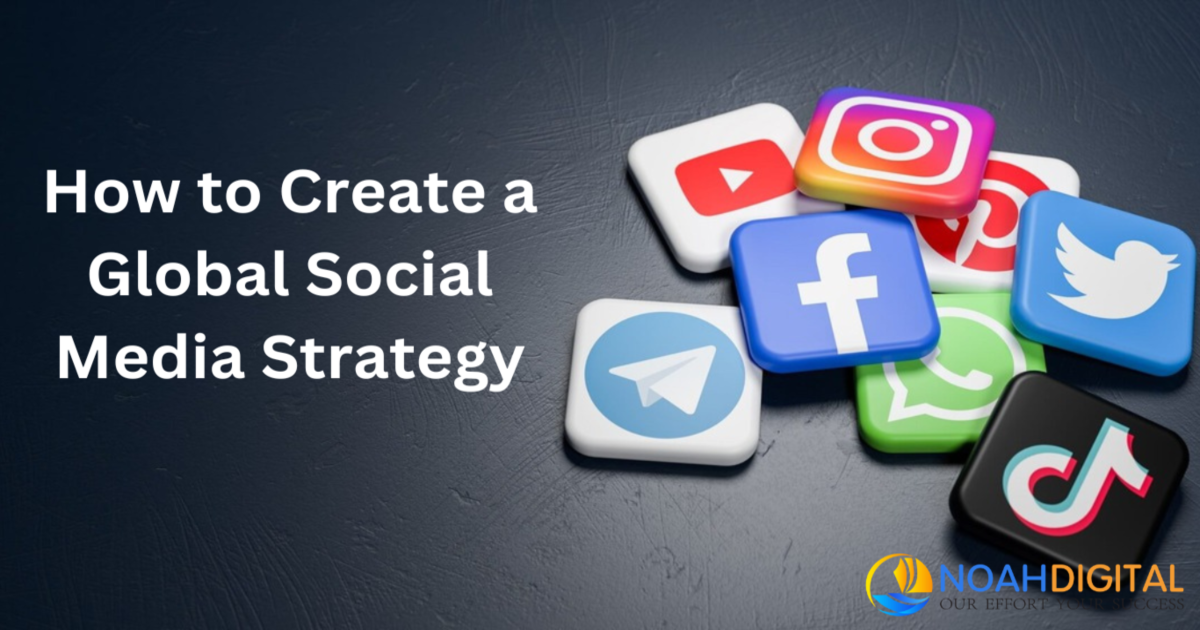
Smart planning greatly improves the success of online businesses in international markets. For small businesses, a well-thought-out global social media strategy reduces marketing risks and increases returns. The challenge lies in using social media marketing effectively, especially when resources and staff are limited. Important steps involve knowing your international audience, setting clear objectives, choosing the right popular social platforms across different countries, studying competitors abroad, and smartly using your resources for the biggest impact. This guide gathers vital tips to help small business owners without big marketing departments improve their approach to social media on a global scale.
Table of contents
- The Importance of Social Media for Your Global Business
- Social Media Builds Global Brand Reputation and Loyalty
- Social Media Supports Better Global Public Relations Outcomes
- Crisis Management in Global Markets Through Social Media
- What Type Of Behaviour Can Spark A Social Media Crisis?
- Social Media Crisis Management Tips For Business And Brands
- Social Media Supports Wow-Worthy Customer Experiences
- Steps To Build A Global Social Media Strategy
- Measure Your Results
- Free Tools for Managing a Global Social Media Strategy in 2024
- Conclusion
The Importance of Social Media for Your Global Business
Social media stands as a beacon of opportunity for global businesses, unlocking doors to unparalleled growth and connection. Imagine the power of engaging directly with your customers, tapping into the heartbeat of market trends, and spreading your brand’s message across borders without the constraints of traditional marketing.
Social media isn’t just a tool; it’s a dynamic canvas where your business can paint its future, attract and retain a loyal customer base, and carve out a unique space in the international market. It offers the chance to dramatically lower marketing costs while increasing revenue through strategic advertising and community building.
Social Media Builds Global Brand Reputation and Loyalty
Maintaining a good global reputation is super important, especially when times are tough economically. According to The 2023 State of Social Media Report, business leaders worldwide focus on building their global brand’s reputation and keeping customers loyal, especially when markets are unpredictable.
Most people agree that social media is key for managing reputation nowadays. 94% of leaders think it helps keep customers loyal to the brand. Social media lets companies talk directly to their customers, making real connections that stick around even when things get rough.
Source: sproutsocial
Social Media Supports Better Global Public Relations Outcomes
The way businesses promote themselves has changed worldwide. Sending press releases to a few reporters isn’t enough anymore. You have to create an interesting story about your brand that gets people talking. If you don’t, you’ll blend in with everyone else.
Social media helps businesses stand out globally by giving them lots of ways to share interesting content and stories. It’s become important for top bosses to use social media because it lets them share their ideas and show off what they know.
A strong global social media presence for your company, including your boss, isn’t just about getting followers and likes. It allows you to spread your message globally and control how people see you in the media worldwide. You can talk directly to your customers and positively shape the conversation about your brand.
Source: sproutsocial
Crisis Management in Global Markets Through Social Media
In today’s global business landscape, crises can strike any company, regardless of size or reach, all thanks to social media. Whether it’s a misjudged comment by an employee that goes viral or a wave of complaints due to a service hiccup, businesses must be prepared.
Social media plays a vital role in global crisis management for two reasons. Firstly, it enables businesses to actively monitor and address issues before they spiral out of control. Secondly, by swiftly responding on social platforms, companies can mitigate the impact of crises and demonstrate their commitment to resolving issues effectively globally.
Source: sproutsocial
What Type Of Behaviour Can Spark A Social Media Crisis?
Insensitive or out-of-touch comments, like this poorly received post from Burger King on International Women’s Day.
The intention was to offer a cheeky take on this sexist phrase and celebrate its female restaurant chefs, but the tone got lost on Twitter, and the fallout was swift.
Hypocritical posts raise hackles, too. American Airlines’ rainbow-washed Tweet about their new fleet decorations inspired some angry reactions from people who called out the company’s donations to anti-LGBTQ organizations.
All these are to say that as an organization, you should define how much of a change in sentiment you need to see before you start thinking about the event as a potential “social media crisis.” Once the numbers hit that threshold, review the situation with the appropriate people to decide whether to implement your crisis communication plan or reach out through customer-service channels individually to people leaving comments.
Social Media Crisis Management Tips For Business And Brands
When managing a social media crisis, it’s crucial for businesses and brands operating in international markets to act swiftly and thoughtfully. Here are some condensed tips tailored for global audiences:
Respond Promptly: Quick action can prevent the escalation of a crisis. This could mean removing an inappropriate post or issuing an apology. The goal is to address the issue before it festers, similar to how Burger King UK quickly apologized for a tweet that was perceived as sexist.
Check Your Social Media Policy: A clear policy can prevent crises. It should cover appropriate content, privacy guidelines, confidentiality, and brand voice, ensuring employees understand what is expected of them. This helps avoid situations like Dollar General faced after an employee’s post.
Dollar General faced criticism after one of its managers shared a not-so-flattering look behind the scenes at the company. Ideally, your business doesn’t inspire employees to critique you publicly, but a social media policy can help mitigate even well-intentioned posts about your brand.
Have a Crisis Communication Plan: Prepare a plan detailing how to respond to various crises. This should outline roles, responsibilities, communication channels, and pre-approved messages. Such preparation is vital for immediate action, as seen when the Quebec health authority swiftly corrected a mislinked URL.
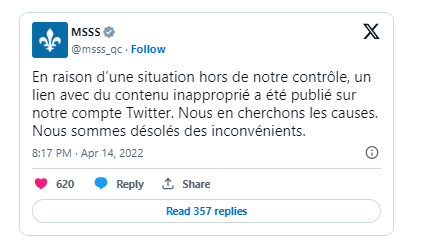
Practice Social Listening: Monitoring brand mentions and social sentiment can alert you to potential issues before they escalate. This proactive approach can help you adjust your strategy in real time, much like Snickers did after negative feedback on a commercial.
When Snickers received backlash on social media about a bigoted commercial they ran in their Spanish market, they took note. The ad was quickly pulled from Spanish TV. But if the company hadn’t been watching social sentiment, it may have never realized how offensive the advertisement was.

Engage Empathetically with Commenters: Acknowledge and respond to public concerns without getting defensive. Aim to move heated discussions to private channels, maintaining a professional and empathetic tone.
Keep Internal Communication Flowing: Ensure all employees are informed about the situation and the company’s response strategy. This helps prevent misinformation and rumours within the organization.
Secure Your Accounts: Implement strong security measures to prevent unauthorized access to your social media accounts. Use centralized systems to manage permissions and secure passwords.
Pause Scheduled Posts: Review and possibly pause scheduled content to ensure all communications are appropriate and sensitive to the situation. Inappropriate timing can exacerbate the crisis.
By adhering to these strategies, businesses and brands can navigate the complexities of a social media crisis more effectively, especially in the nuanced landscape of international markets.
Social Media Supports Wow-Worthy Customer Experiences
Businesses worldwide now have a golden opportunity as more and more customer interactions are shifting to digital platforms. These interactions are no longer private; they occur in public forums where they can reach a global audience.
This emphasizes the crucial need for global brands to develop effective social media customer care strategies. It’s not merely about responding to inquiries anymore. To succeed in the global market, businesses must actively engage in relevant conversations, whether directly tagged or not.
Source: sproutsocial
Businesses can consistently surprise and delight their global audience by leveraging comprehensive social listening tools and implementing well-optimized social media engagement plans. By exceeding expectations, companies can foster loyalty and strengthen their position in the global market.
Steps To Build A Global Social Media Strategy
92% of marketers say social media is key for their business. But making a good social media plan that works worldwide isn’t just about trying the newest apps. It’s about picking the right places to be online and learning how to do well in social media marketing, especially for businesses that reach out to people in different countries.
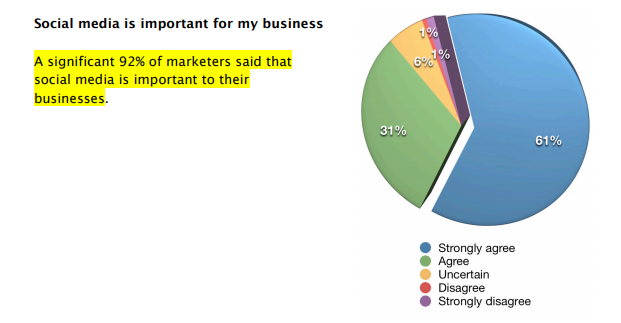
Source: socialpilot
Identify Your Target Demographic Globally
Identifying your target demographic globally is vital to a business’s growth and sustainability, necessitating a comprehensive and continuous approach. Incorporating a global social media strategy into this process can significantly enhance your understanding and engagement with diverse customer segments worldwide. Here’s a structured approach to achieve this:
- Setting Business Goals: Begin by clarifying your unique selling points and the specific problems your product or service solves, focusing on the global audience who will benefit the most. This process is crucial because setting goals that are challenging but achievable can lead to a 90% improvement in performance. For instance, if your product is a language learning app, consider how it meets the needs of learners in various countries, considering different language backgrounds and learning objectives. This resource can provide further insights into creating a digital marketing strategy for the global market.

- Analyzing Current Customers: Leverage data from your online platforms to understand the demographics of your international customers. For example, website analytics might reveal that your e-commerce fashion brand is particularly popular among women aged 18-34 in urban areas of France and Japan. Use this data to refine your marketing strategies for these regions.
- Conducting Market Research: Utilize market research tools to analyze the demand for your products in different international markets. For example, if expanding to the South Korean market, look into age groups, income levels, and popular trends. Tools like Google Trends and social media insights can reveal that skincare products are highly favoured among both men and women in South Korea, pointing towards a lucrative opportunity for beauty brands.
- Competitive Analysis: Study your competitors in target international markets to understand who they’re appealing to. For example, if you’re entering the Australian market with a fitness app, analyze local competitors to see their target demographics, such as millennials interested in outdoor activities. This can help you identify niches, like fitness programs tailored for surfing enthusiasts, which are underexploited. This analysis is essential for developing a robust global social media strategy.
- Creating Buyer Personas: Craft detailed buyer personas for each international market with the data collected. Suppose you’re selling eco-friendly home goods; you might create personas for European markets, such as “Eco-conscious Emma,” a 30-year-old professional in Berlin interested in sustainability with a medium to high-income level. These personas allow you to tailor your product offerings, marketing messages, and ads to resonate deeply with specific international audiences, enhancing the effectiveness of your global reach.
By staying abreast of digital marketing trends and incorporating these strategic elements, businesses can significantly improve their global reach and engagement, ensuring they meet the evolving needs of their target demographic worldwide.
Craft Your Brand’s Global Voice
Crafting your brand’s global voice is more than just a marketing strategy; it’s necessary in today’s highly connected world. With the rise of social media, brands have an unparalleled opportunity to reach out and connect with audiences on a global scale. The statistics speak volumes: 80% of Americans and an overwhelming 90% of the UAE’s internet users are active on social platforms like Facebook. In China, 84% of the population uses social media to research potential purchases. This global connectivity underscores the importance of developing a comprehensive international social media strategy for a global audience following the latest trends to effectively engage with a diverse audience. Here’s how you can do just that:
- Understanding Your Audience: Before marketing in a new area, learn about local culture, what’s okay to say and do, and how people like to be marketed. This means looking into the words, emojis, and holidays you plan to use in your posts. Starting with Social Listening is a good move. It lets you dive into the local culture and talk to figure out the best way to connect with new people. Watch what local businesses and folks are doing on social media and how people react to it. This can give you clues on local trends you can join, the special words they use, and what they like to talk about. This way, you can make your posts more relevant and interesting to them.
- Tailoring Your Content: Adopting a one-size-fits-all approach in content creation fails to engage diverse international markets effectively. A multinational company like McDonald’s tailors its social media content to reflect local tastes and festivals, highlighting local menu items during specific cultural celebrations in Asia while focusing on sustainability practices in European markets, thereby maintaining a cohesive brand voice while respecting local preferences.
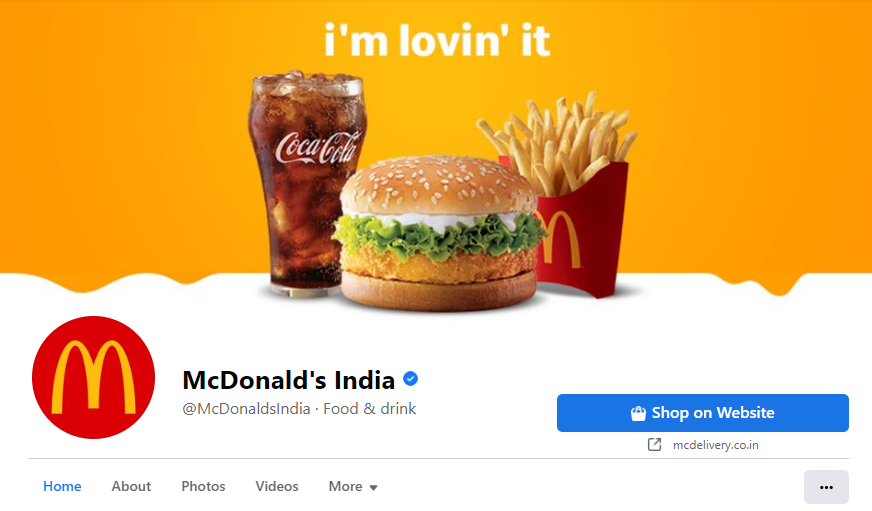
- Engaging Authentically: Authentic engagement involves more than just publishing content; it requires active interaction with the audience. For instance, Spotify creates country-specific playlists and engages with users by asking for song recommendations on local holidays, making the brand feel more relatable and integrated within different cultures.
- Taking Note Of Your Vocabulary: When talking to people who don’t speak English as their first language, you might have to change how you use English. Ask yourself if you use any words or phrases that could confuse others. Do you talk about movies, music, or jokes that not everyone would know? A simple way to make your messages clearer is to write shorter sentences and use easier words. Complex sentences can be hard for everyone to understand. You want everyone to get what you’re saying easily. Be careful with your posts, even the emojis. Emojis can mean different things in different places. For example, a waving hand is friendly in the US but could be seen as saying goodbye to a friend in China. A thumbs up is okay in many countries but can be rude in some parts of the Middle East. Always check before you post to avoid misunderstandings. Try using local words, phrases, or references that fit right in with the place you’re talking to. For example, Nando’s Twitter account in Malaysia uses local slang and mentions local news sources to connect better with their audience.

- Monitoring and Adapting: Employ analytics tools to conduct a digital marketing audit for global markets. This approach allows brands like Zara to adapt quickly, using real-time data to understand what types of fashion trends are in different regions, enabling them to adjust their best social media marketing strategies to highlight popular items while staying relevant and engaging to a global audience. This agile approach to analytics ensures that your brand can quickly pivot strategies to meet the ever-changing demands of international markets.
Select Preferred Social Media Platforms Internationally
Leveraging insights from your international customers enables you to significantly enhance your global audience impact. Understanding their preferences and behaviours can refine your marketing strategies and optimize your advertising efforts. Crucially, this data-driven approach helps you identify the most relevant social media platforms for your target demographics across different countries.
The objective isn’t to spread your efforts thin across every possible platform; instead, it’s about focusing your presence on popular and trusted platforms within your target markets. For instance, while Facebook and Instagram might be the go-to platforms in North America and Europe, in China, platforms like WeChat and Douyin are essential for reaching your audience. Similarly, VKontakte is pivotal in Russia, and Line is crucial in Japan and Thailand. This targeted approach ensures that your marketing efforts are concentrated where they will be most effective, making it a fundamental aspect of a successful global social media strategy.
Think about the unique features of these platforms:
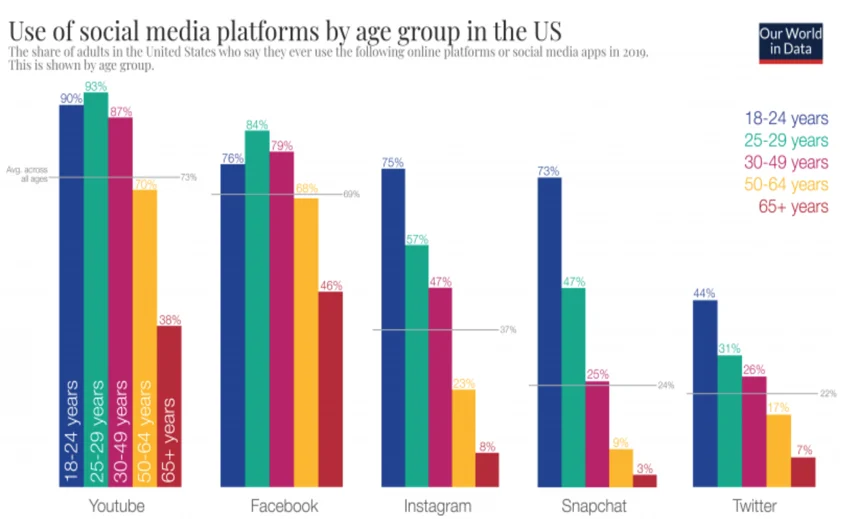
- LinkedIn attracts a professional, educated crowd, perfect for content specific to your industry. On LinkedIn, companies usually have one global account since English is common for international business. Yet, you can write your profile’s About section in several languages and target posts to specific regions or languages. LinkedIn’s Showcase pages let you focus on different parts of your business or regions, like Northern or Southern Europe, helping to share more relevant content.
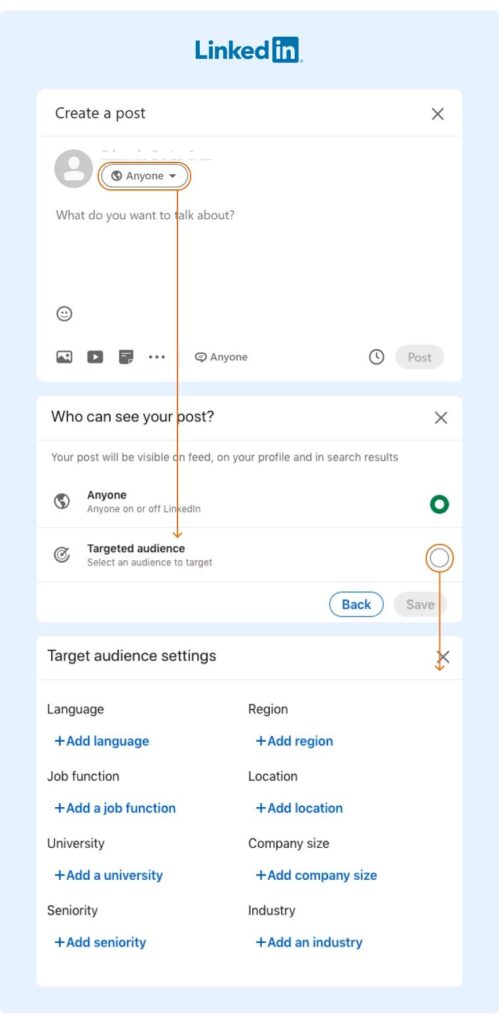
- Facebook’s Global Pages feature lets businesses show localized content from one main page, using a visitor’s location to decide which version they see. So, if Americans visit Mexico, they still see the American page, thanks to IP address tracking. Companies can create Market pages for specific areas to share local content in the right language, but it’s good to have someone check if it fits the culture. Each Market page can have its inbox and admins, making managing it easier. This setup lets you push region-specific promotions without dividing your audience’s attention on the main Global page.
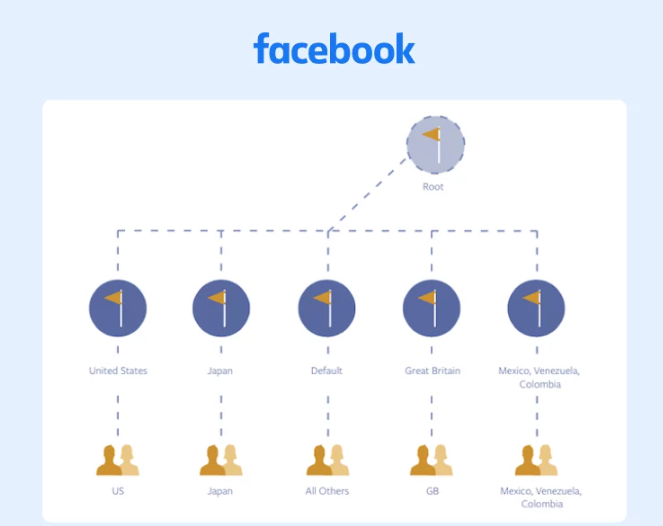
Facebook and YouTube are excellent for advertising and promoting your brand to a wide audience. Moreover, Facebook remains the largest social network worldwide, boasting over 3 billion monthly active users. Learning about successful Facebook ad strategies can also inform how you collaborate with influencers across different platforms.
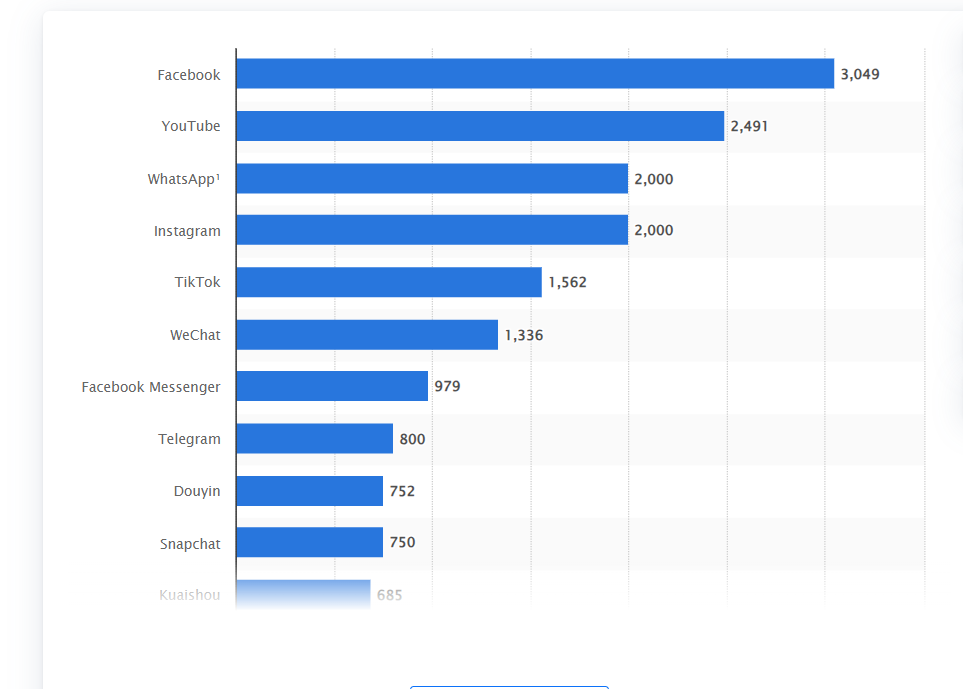
Source: Statista
- Instagram doesn’t offer global pages, so everyone sees the same posts, no matter where they are. This could limit understanding for those who don’t speak the post’s language, reducing engagement. Some brands create local Instagram accounts to target different regions, like Starbucks in Hong Kong, which allows for local promotions and collaborations but can split your audience.
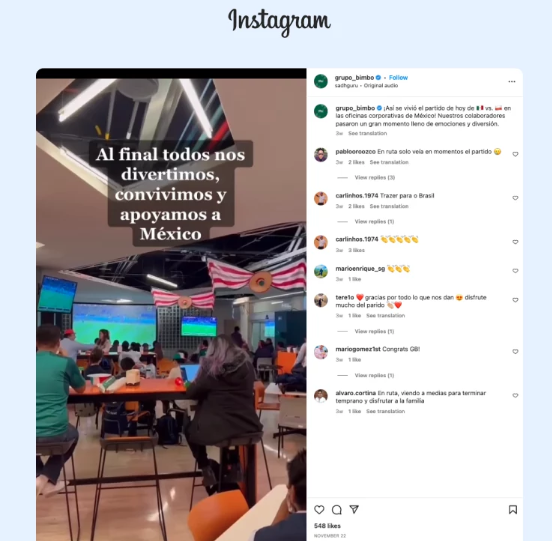
- Twitter is similar to Instagram because you can’t target by location, so brands use one global account or set up separate accounts for different regions. Separate accounts allow for tailored content and might engage better, but they also split your total engagement and require more resources to manage.
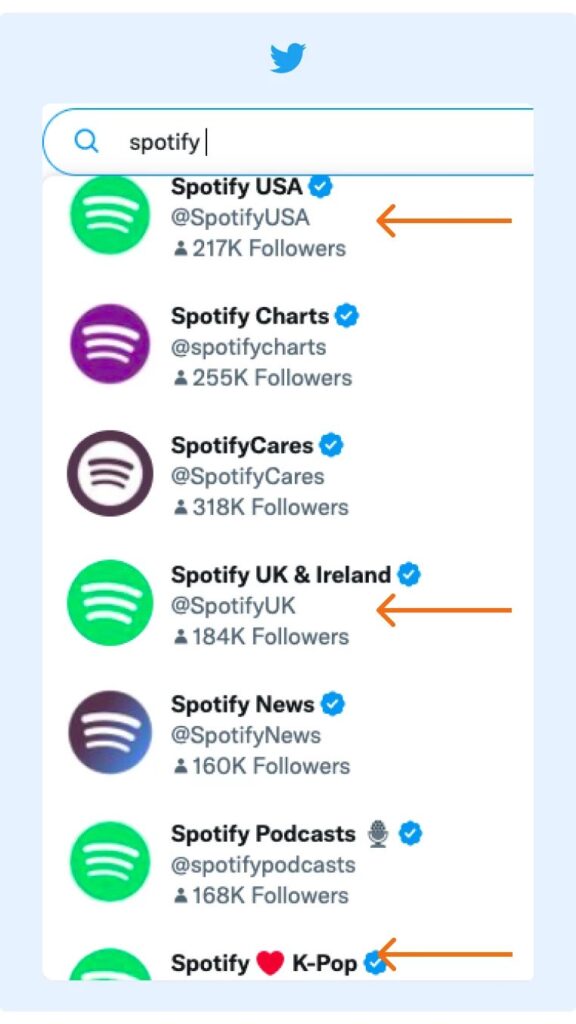
Choose a platform that matches your target customers to effectively focus your efforts and resources. Additionally, a website’s visibility through search engine optimization (SEO) services can further enhance your brand’s global reach.
While it might seem wise to be active on many social media sites, picking the ones that best fit your audience is crucial. Understanding the differences between the platforms helps you allocate your advertising budget and time more efficiently. For instance, a clothing e-commerce site might do better on Facebook and Instagram than on LinkedIn. A beauty brand could leverage Snapchat and Instagram Stories for makeup tutorials, while Twitter could be a go-to for handling customer service.
Establish a Global Social Media Workflow
In an increasingly digital world, leveraging social media has become a critical strategy for businesses aiming to amplify their brand presence and engage effectively with their target audience. Establishing a strategic social media workflow is paramount, as it transitions businesses from being reactive to proactive in their digital engagements, allowing for creativity and strategic foresight in content creation and audience interaction. This article outlines a comprehensive approach to crafting an effective social media strategy to elevate your brand’s digital footprint.
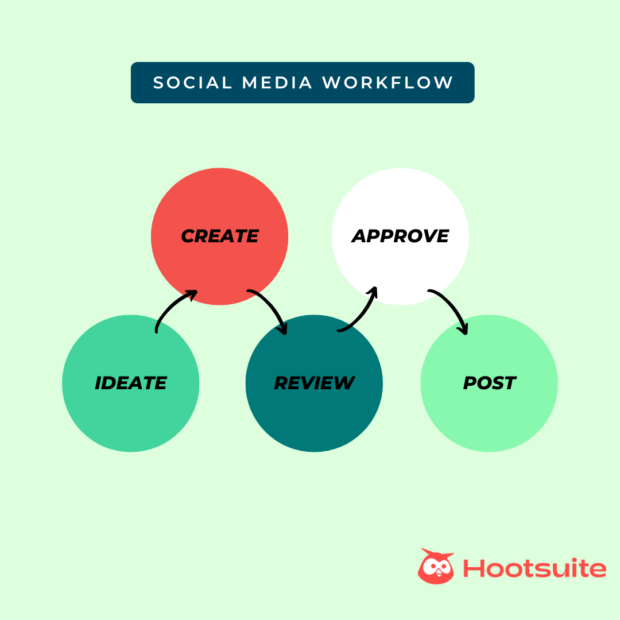
Source: Hootsuite
Step 1: Identify Your Ideal Customer Persona (ICP) for Each Market
Demographics: Understand the age, gender, profession, and economic status of your target audience in different regions.
Pain Points: Identify specific challenges they face that your product or service can solve.
Location and Cultural Preferences: Acknowledge cultural nuances, languages, and local trends.Interests and Habits: Consider how cultural, social, and environmental factors influence their interests and online behaviours.
Step 2: Establish Your Goals and Guidelines
When establishing your social media strategy for global markets, aligning your goals and guidelines with international audiences’ diverse and dynamic nature is crucial. Here’s a concise approach:
Define Your Social Media Mission Statement
- Purpose-Driven Content: Ensure your social media mission reflects your company’s global mission to deliver high-quality, accessible content tailored to marketing professionals worldwide.
Determine Key Attributes of Your Social Presence
- Community Building: Foster learning and discussion across different cultures and languages.
- Authenticity and Transparency: Engage with a global audience genuinely, respecting cultural nuances.
- Personal Interaction: Encourage direct communication to make your brand more relatable worldwide.
- Value Creation: Provide practical, immediately applicable benefits for a diverse audience.
- Inclusivity: Represent and engage with people across all demographics, respecting cultural, religious, and sexual diversity.
Document Guidelines and Best Practices
- Consistent Brand Voice: Maintain a recognizable brand voice that resonates across different regions.
- Cultural Sensitivity: Tailor content, including templates, brand colours, and messaging, to respect and appeal to various cultures.
- Engagement Strategies: Focus on solving problems, sparking discussion, and encouraging interactive content without relying heavily on promotional language.
- Accessible Content: Share valuable insights freely, minimizing barriers to content access.
- Actionable Insights: Provide clear, actionable tips and prompts to engage a global audience.
Set Specific Metric Goals
- Realistic Targets: Aim for measurable growth in followers, engagement rates, diversity of engagement, and content volume, considering the baseline metrics and cultural differences.
- Tactical Strategies for Achievement: Outline clear, culturally aware strategies to reach these goals, including localizing content, leveraging local influencers, and using platform-specific features effectively.
Step 3: Create a Social Media Calendar
To manage your social media content for global markets effectively, follow these streamlined steps:
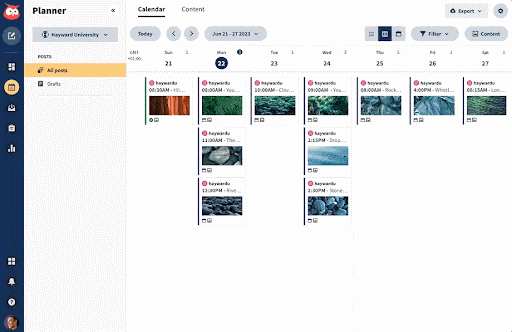
Establish a Posting Cadence: Determine a consistent posting schedule based on your social media goals, team capacity, and each platform’s algorithm to build and maintain audience trust.
Plan Monthly in Advance: Organize your content themes, diversify topics, and plan your posts a month ahead to stay strategic and flexible. Use tools like social media management platforms (e.g., Hootsuite, Buffer) for scheduling to save time and ensure consistency.
Stay Adaptable: While having a plan is crucial, remain open to incorporating trending topics and current events to keep your content timely and engaging for a global audience.
Step 4: Create social media captions
To create compelling social media captions for international markets, follow a streamlined approach that grabs attention, communicates effectively across cultures, and prompts action:
Start with a Global Hook: Begin with an intriguing statement or question that resonates globally. Use surprising facts, insightful questions, or universal stories to draw a diverse audience. Consider cultural nuances to ensure the hook is globally appealing.
Highlight a Universal Problem: Identify a common issue that transcends cultural and geographical boundaries. Show empathy and understanding to connect with a global audience personally, making it clear you understand their challenges.
Offer a Broad Solution: Present an applicable and beneficial solution across different markets. Whether it’s a unique approach, innovative idea, or a new perspective, ensure it addresses the universal problem you’ve highlighted and is adaptable to various cultural contexts.
End with a Clear Call to Action: Encourage global engagement by ending with a question or prompt that invites conversation and interaction from a wide audience. Make your call to action simple but compelling, encouraging participation from people across different regions.
Step 5. Schedule your social media posts
Leveraging a scheduling tool is essential for efficient social media management across global markets. Here’s a concise overview of the top tools to consider:
Hootsuite: Offers comprehensive scheduling and analytics starting at $49/month. It supports multiple platforms, including LinkedIn, Twitter, Facebook, Instagram, Pinterest, YouTube, and WordPress. Ideal for monitoring social media trends and brand mentions with a user-friendly interface.
Buffer: User-friendly with a starting price of $15/month. Known for its ‘Buffer Queue’ feature, allowing precise scheduling control. Includes a Chrome extension for easy posting. Supports LinkedIn, Twitter, Facebook, Instagram, and Pinterest.
Later: Visually focused and great for Instagram with a free plan available. Starter plans begin at $12.50. Features include a visual planner, hashtag search, and scheduling for Instagram Stories. Supports Instagram, Facebook, Twitter, and Pinterest.
SproutSocial: Starts at $99/month, offering advanced features like review management, profile monitoring, and a content library. Supports LinkedIn, Twitter, Facebook, Instagram, Pinterest, and YouTube. Suitable for businesses seeking in-depth analytics and content management.
HeyOrca: Tailored for agencies at $99/month plus $49 for each additional calendar. Features a shared calendar view and unlimited storage for each client’s media library. Supports LinkedIn, Twitter, Facebook, Instagram, Pinterest, and Google My Business.
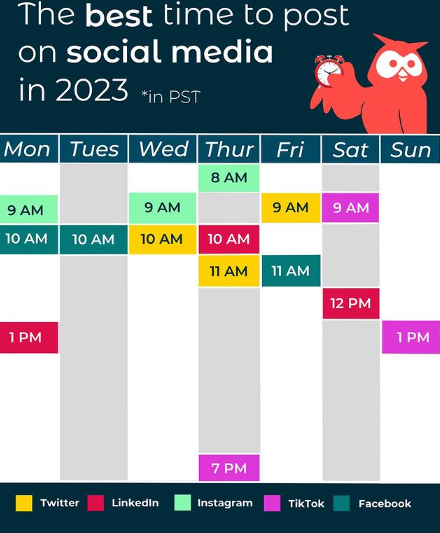
Decode Social Media Algorithms for Global Reach
When tailoring your social media strategy for international markets, it’s crucial to adapt your approach based on each platform’s unique algorithms and cultural preferences. Here’s how you can apply the insights for each platform, specifically focusing on engaging international audiences: with a global social media strategy:
- Localized Engagement: Encourage high engagement by creating content that resonates with local cultures and trends. Use language and imagery that appeal to specific international markets.
- Content Quality: Ensure authentic, informative, and culturally relevant content. Collaborate with local influencers or brands to increase authenticity and trustworthiness.
YouTube
- Watch History & Performance: Tailor content to users’ viewing habits and preferences in different regions. Consider creating region-specific channels or content in local languages.
- Context & Watch Hours: Develop series or playlists catering to viewers’ interests in specific countries. Longer, engaging content that captivates international audiences can improve your channel’s visibility.
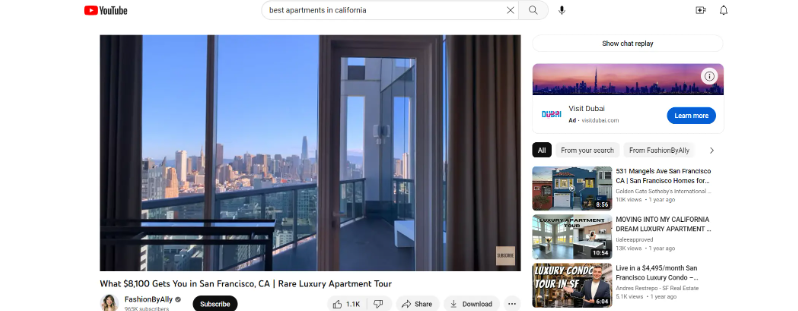
- Feed & Stories: Use geo-tagging and local hashtags to increase visibility in specific markets. Share stories and posts celebrating local festivals, traditions, or landmarks to engage with international audiences.
- Explore & Reels: Leverage trending topics and music from different countries to make your content more discoverable to international users. Feature collaborations with creators from those markets.
Recency & Popularity: Utilize trending hashtags and topics relevant to international events or discussions. Timing your tweets to match the peak hours in different time zones can also increase engagement.
- Post Quality & Early Engagement: Share industry insights, case studies, or success stories relevant to your target international market. Engage with local businesses and professionals to increase your content’s reach and relevance.
- Website Quality & Engagement: Pin content that reflects international tastes and preferences, ensuring your website content is localized and appealing to different cultures.
TikTok
- Content Relevance & User Interaction: Create TikToks that incorporate global trends with a local twist. Use popular sounds and challenges in different languages to attract a wider, international audience.
Social media algorithms are designed to track user behaviour and tailor content to individual preferences. Here are condensed examples illustrating how these algorithms operate on platforms like Twitter, Instagram, and Facebook:
- Twitter Algorithm: If you frequently engage with influencer marketing content, Twitter recommends posts from niche micro-influencers aligning with your interests.
- Instagram Algorithm: Instagram asks users if they are interested in certain posts. Selecting “Not Interested” teaches the algorithm to avoid showing similar content in the future, refining content relevancy.
- Facebook Algorithm: Meta enhances user experience by using algorithms to suggest sponsored posts. These are tailored based on user interests, aiming to increase engagement and satisfaction for both users and brands.
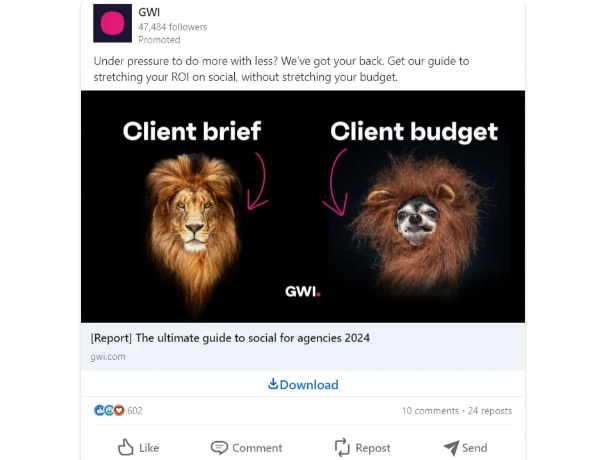
Developing a Content Strategy for Diverse Audiences
66% of consumers think short-form video is the most engaging in-feed content. Developing a content strategy for diverse audiences, especially within a global social media strategy, involves several key actions:
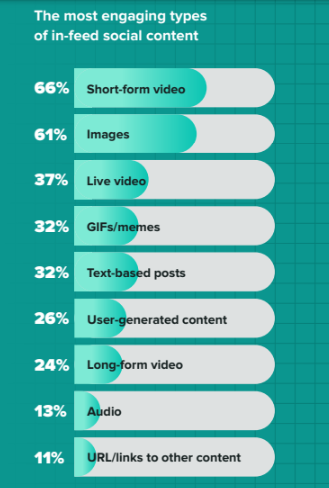
Source: sproutsocial.com
- User-Generated Content (UGC): Harness the authenticity of UGC to show real stories from a diverse customer base, promoting inclusivity and trust.
- Paid Advertising: Use targeted ads to address different audience segments’ interests and needs, improving engagement and conversions. Through PPC management services, your strategy can include precisely targeted ads that speak directly to your audience’s preferences and interests.
- Influencer Marketing: Another benefit of creating content for specific regions is that you can work with local influencers popular in that demographic. This is beneficial for a few reasons:
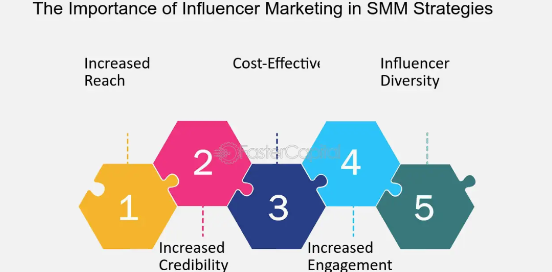
- The campaigns will resonate more with that regional audience.
- It’s usually cheaper to collaborate with micro-influencers.
For example, Bed Bath and Beyond is another global brand that collaborated with Mexican decor micro-influencer Flor Martinez. They posted the campaign on the Bed Bath and Beyond Mexico account, which was well received.

- Audience Research: Conduct thorough research to understand the distinct preferences, aspirations, and challenges of various segments, aligning your content accordingly.
- Content Segmentation: Find common themes that resonate across different demographics while tailoring content to specific groups for broader appeal.
- Inclusive Storytelling: Share stories from diverse perspectives to showcase your commitment to representing all voices, enhancing trust and cultural appreciation.
- Diverse Content Formats: Offer content in various formats (e.g., videos, blog posts, infographics) to cater to the different preferences of your audience, ensuring accessibility and engagement.
- Cultural Sensitivity: Be mindful of cultural nuances in your content to avoid stereotypes and build genuine connections with your audience.
- Data-Driven Decisions: Regularly analyze performance data to refine your strategy, ensuring content remains relevant and engaging for each segment.
- Multilingual Content: Provide content in multiple languages to reach and resonate with non-English speakers, demonstrating respect for linguistic diversity.
- Feedback Loop: Actively seek and incorporate feedback from diverse audience segments to continually adapt and improve your content strategy, fostering a sense of community and loyalty.
- Incorporate Local Hashtags: Region-specific hashtags can extend your social media post’s reach. For instance, McDonald’s Pakistan utilized local trending hashtags, such as #PAKVSENG, around the time of the FIFA World Cup to engage with the Pakistani community.
If you’re using a social media management platform like Sprout Social, you can look at all your data and analytics in one place. Use Sprout’s Report Builder for a holistic view of your posts’ performance.
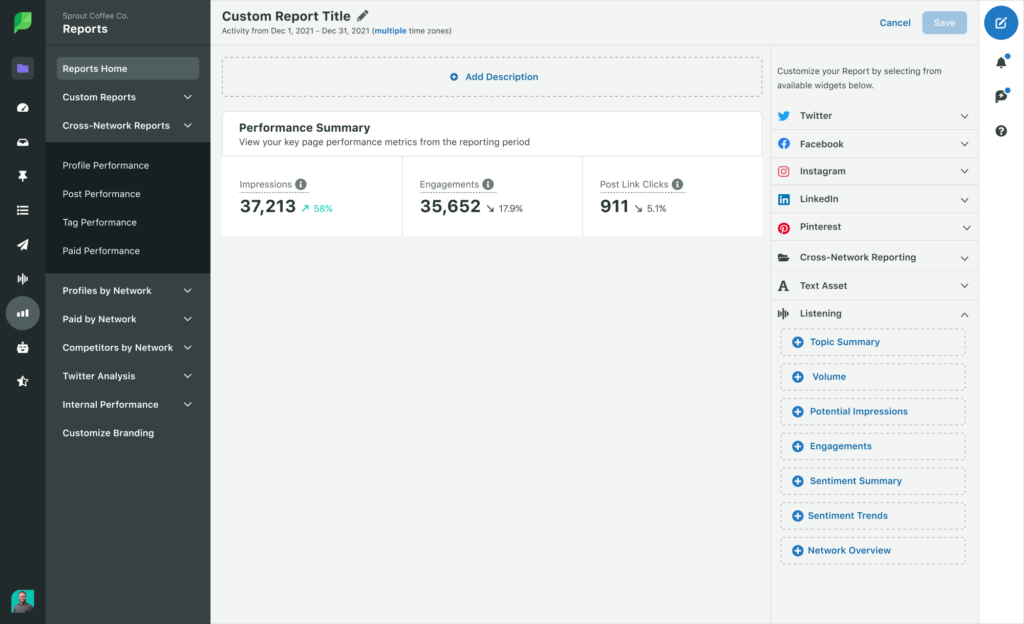
Measure Your Results
There are countless things to track on your social media channels. Start by looking at how much traffic your social accounts drive to your website or blog. This initial step is crucial in understanding the impact of your global social media strategy on your overall digital footprint.
Social media platforms offer tools to help businesses track analytics.
For example, you can use Facebook’s Page Insights, Instagram’s Account Insights, and LinkedIn’s Visitor Analytics to see what people are responding to and look for trends related to topics or keywords that generate the most interest.
Once you get an idea of your average traffic and post-performance, set goals for key metrics and keep a scorecard to measure your progress.
Be sure to choose metrics that are easy to gather because if it’s too time-consuming to track, you won’t be motivated to do it.
Examples of simple metrics include the total number of interactions, traffic to your website, and sales or revenue that can be attributed to social.
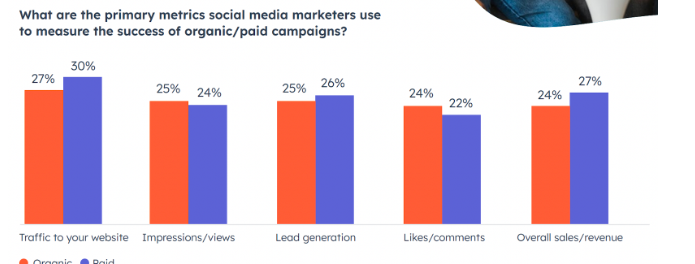
Source: hubspot.com
Free Tools for Managing a Global Social Media Strategy in 2024
Navigating the complexities of a global social media strategy in 2024 requires a savvy approach, especially when leveraging the best tools without overstretching your budget. Thankfully, many free tools are at your disposal, designed to streamline your efforts and maximize impact across diverse international landscapes:
- Buffer’s Free Plan provides an intuitive platform for scheduling posts, analyzing performance, and managing all your social media accounts from one dashboard. It’s perfect for ensuring your content reaches your audience at the most opportune times, regardless of their location. Imagine effortlessly planning a week’s worth of posts across different time zones, ensuring your message resonates with followers in New York just as effectively as it does with those in Tokyo.
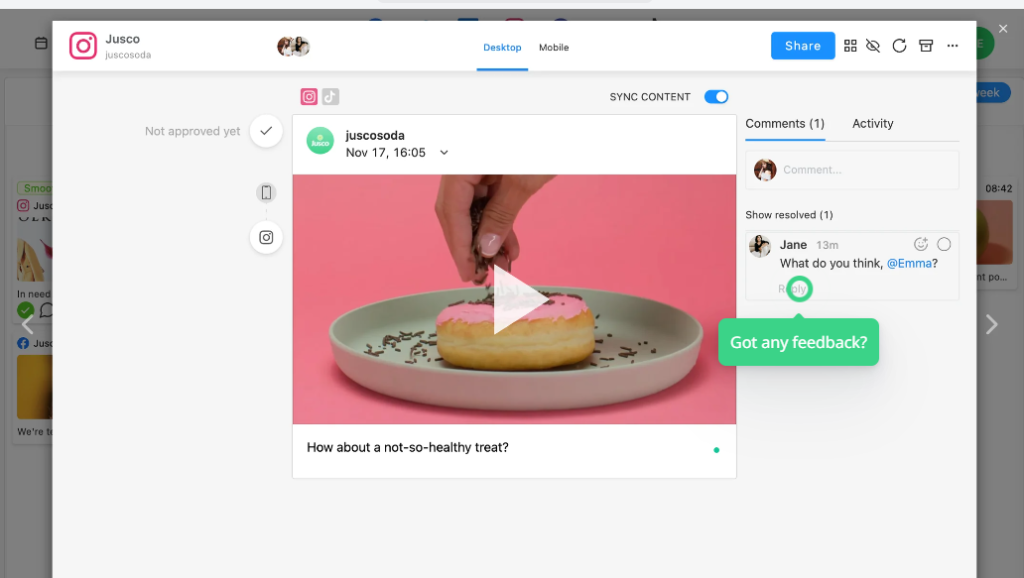
- Trello shines in project management, helping you organize your content calendar, collaborate with team members, and track the progress of your campaigns. It’s invaluable for coordinating global campaigns, where keeping track of deadlines, content creation, and team responsibilities can become daunting without the right organizational tools.
- Canva remains an indispensable asset for creating visually captivating content tailored to various markets without needing extensive design skills. Whether it’s designing infographics that break down complex information for your audience in Brazil or crafting eye-catching banners for your followers in South Korea, Canva helps your content stand out in a crowded digital space.
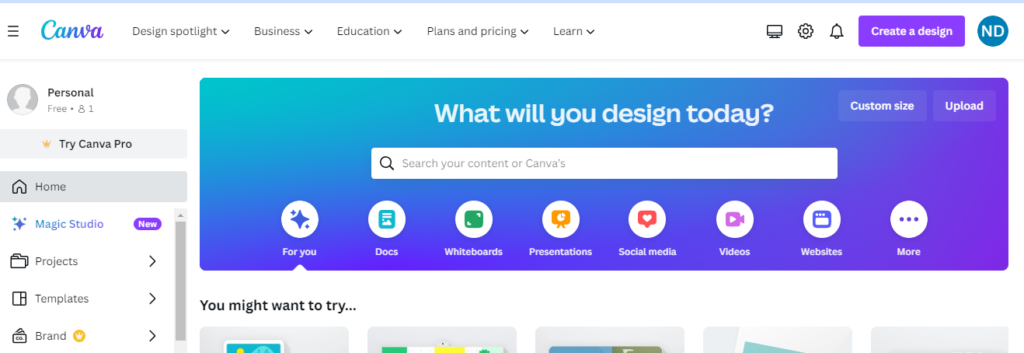
- Panoramiq Insights offers global analytics for Instagram, including posts, Stories, Reels, follower demographics, and tracking new followers. It’s key for brands targeting international audiences, helping tailor content for diverse markets.
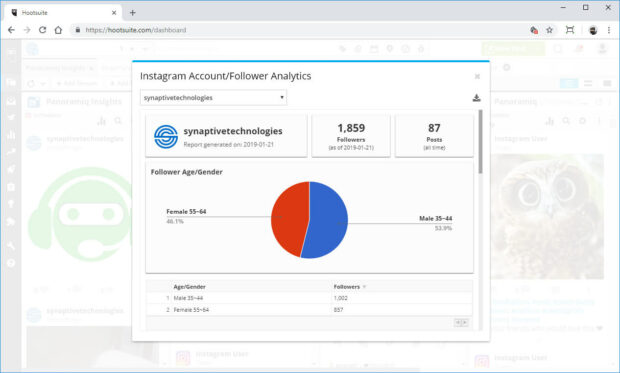
Source: apps.hootsuite.com
Conclusion
Social media can help your brand reach many people worldwide easily and without spending much. It’s a good way to see if people like your products or services in different places. By using social media smartly, you can get your brand known by potential customers early when they start thinking about buying something. It also helps you support your customers after they buy, helping your business grow in different ways and languages. Don’t miss out on the opportunity to enhance your strategy with a CDAP free consultation.
Author's Bio
Dr. Bin Tang, founder and CEO of Noah Digital, is renowned for using AI to turbocharge online businesses and unlock search engine secrets. His innovative ‘7-Step Amplify Sales & Leads in a Year’ strategy and management of massive ad campaigns for Google and Bing have dramatically increased online visibility and sales.

